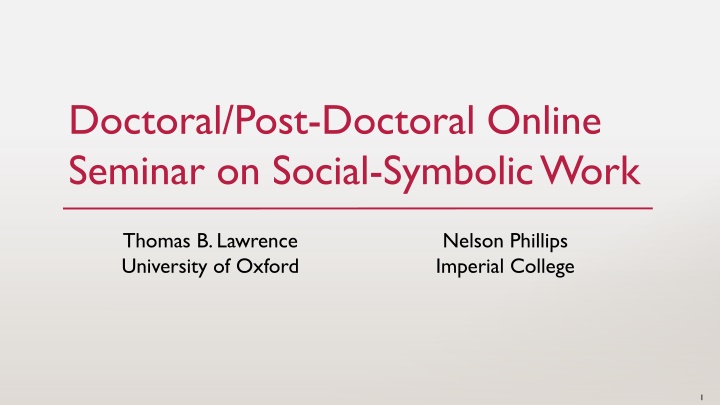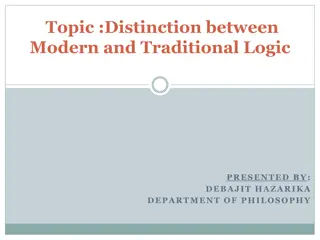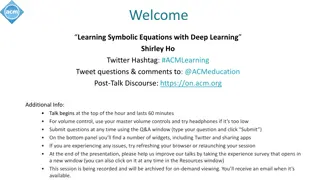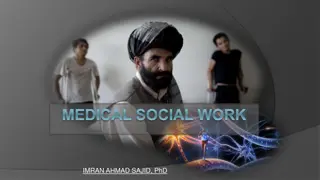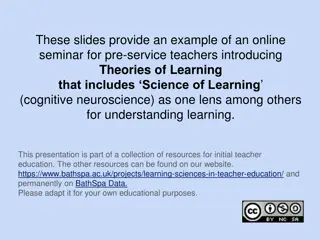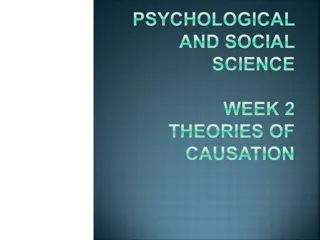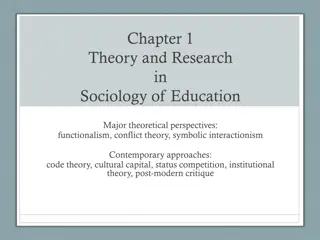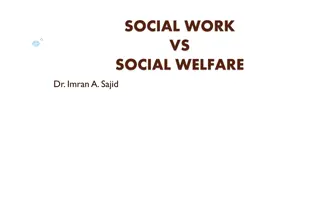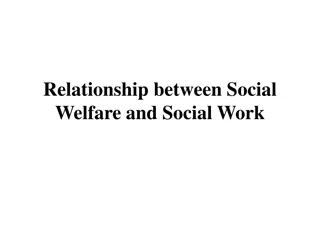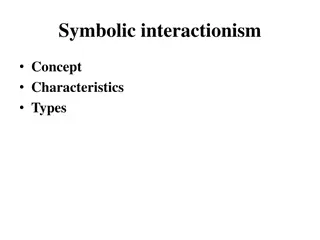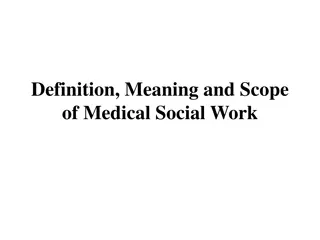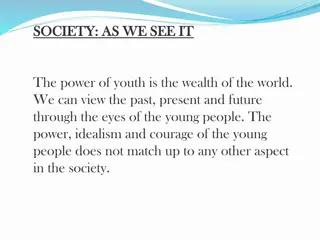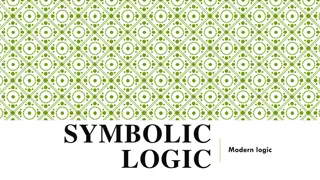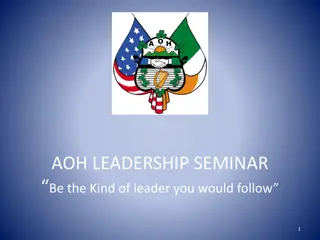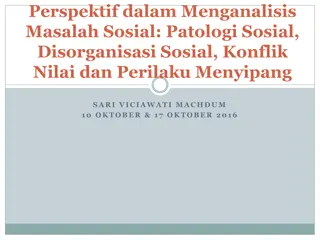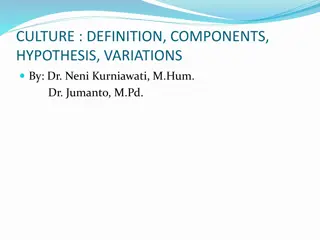Online Seminar on Social-Symbolic Work: Key Ideas and Perspectives
Dive into the study of social-symbolic work with experts from University of Oxford and Imperial College. Explore how people shape social worlds through engaging with social-symbolic objects and networks. Discover the significance of emotions as social-symbolic objects and culturally legitimate patterns within social systems.
Download Presentation

Please find below an Image/Link to download the presentation.
The content on the website is provided AS IS for your information and personal use only. It may not be sold, licensed, or shared on other websites without obtaining consent from the author.If you encounter any issues during the download, it is possible that the publisher has removed the file from their server.
You are allowed to download the files provided on this website for personal or commercial use, subject to the condition that they are used lawfully. All files are the property of their respective owners.
The content on the website is provided AS IS for your information and personal use only. It may not be sold, licensed, or shared on other websites without obtaining consent from the author.
E N D
Presentation Transcript
Doctoral/Post-Doctoral Online Seminar on Social-Symbolic Work Thomas B. Lawrence University of Oxford Nelson Phillips Imperial College 1
OUR AIMS Develop a sophisticated understanding of the key ideas and issues in the study of social-symbolic work Provide opportunities to explore new issues, topics, and research questions that emerged from a social-symbolic work perspective Explore your ideas for the study of social-symbolic work Interact with other scholars interested in social-symbolic work 2 2
Overview of the Social- Symbolic Work Perspective 3
Snow, D. A., & Anderson, L. 1987. Identity work among the homeless: The verbal construction and avowal of personal identities. American Journal of Sociology. Whittington, R., Molloy, E., Mayer, M., & Smith, A. 2006. Practices of strategising/ organising: broadening strategy work and skills. Long Range Planning. Hochschild, A. R. 1979. Emotion work, feeling rules, and social structure. American Journal of Sociology. 1980 1990 2000 Gieryn, T. F. 1983. Boundary-work and the demarcation of science from non-science. American Sociological Review. Ryen, A., & Silverman, D. 2000. Marking boundaries: culture as category work. Qualitative Inquiry. Lawrence, T. B., & Suddaby, R. 2006. Institutions and institutional work. Handbook of organization studies (2nd ed.) 4
THEPROJECT Research question: How do people purposefully shape social worlds? Answer: a) Social worlds are constituted by networks of social-symbolic objects b) People shape social worlds by engaging in social-symbolic work that targets objects and the connections between them 6 6
SOCIAL-SYMBOLICOBJECTS a) A combination of discursive, relational, and material elements b) that constitutes a meaningful pattern c) in a social system (Berger & Luckmann, Giddens, Sewell, Fairclough) Emotions as social-symbolic objects Culturally legitimate patterns of feeling and expression that include important bodily elements 7 7
A QUICK GAMETO GET US GOING Background: We define social-symbolic objects as meaningful patterns in social systems Three broad categories: selves, organizations, institutions The Game: 1) 2 minutes on your own: 1) Make a list of social-symbolic objects that have come into existence in your lifetime. 2) No discussing your answers or asking questions 8-minute breakout: 1) Share, and compare 2) Be ready to put a few of your answers in sticky notes on our shared Jamboard (the link is being put in the chat right now bookmark it as we ll be coming back to it throughout the course) 2) 8 8
SOCIAL-SYMBOLICWORK Purposeful, reflexive efforts of individuals, collective actors, and networks of actors to shape social-symbolic objects a) heterogeneous forms of agency (Emirbayer & Mische) Emotion work Purposeful, reflexive efforts of individuals, collective actors, and networks of actors to shape the expression and experience of emotions b) bundled into programs of action (Kahneman & Tversky, Haidt) c) that enact repertories of practices (Giddens, Nicolini, Schatzki) 9 9
Forms of Social-Symbolic Work Aesthetic work Age work Authenticity work Boundary work Contextualization work Cultural work Discursive work Emotion work Idea work Identity work Institutional work Interaction work Intersectional identity work Meaning work Narrative identity work Practice work Race work Strategy work Temporal work Values work Exemplary Citations 1 2 3 4 5 6 7 8 9 10 11 12 13 14 15 16 17 18 19 20 Warhurst & Nickson, 2009 Collien et al., 2016 Peterson, 2005; Svejenova, 2005 Kreiner, Hollensbe, & Sheep, 2009 Gond & Boxenbaum, 2013 Glynn, 2000; Lounsbury & Glynn, 2001 Lawrence, Phillips, & Hardy, 1999 Hochschild, 1979; Rafaeli & Sutton, 1987 Carlsen et al., 2012 Watson, 2008 Lawrence & Suddaby, 2006 Idrissou et al., 2016 Atewologun et al., 2016 Benford & Snow, 2000 Ibarra & Barbulescu, 2010 Zietsma & Lawrence, 2010 Whitaker, 2005 Whittington, Molloy, Mayer, & Smith, 2006 Granqvist & Gustafsson, 2016; McGivern et al., 2018 Gehman et al., 2013 10
SOCIAL-SYMBOLICWORKIN MANAGEMENTANDORGANIZATIONRESEARCH Emotion work Identity work Career work Self work Strategy work Boundary work Technology work Organization work Practice work Category work Institutional work 11 11
A PROCESS MODELOF SOCIAL-SYMBOLIC WORK Practices Resources Social-symbolic work Motivations Effects Situatedness 12
THINK OFTHIS PHOTOGRAPH AS DATA This photo/exercise is also on p. 2 of our Jamboard so you can see them in your breakout rooms (please put your answers on p. 3 of the Jamboard) 1) What social-symbolic objects do you observe? 2) What forms of social- symbolic work can you imagine are important to constituting the scene? 3) What would be a research question that you might ask about the objects and work? 13
